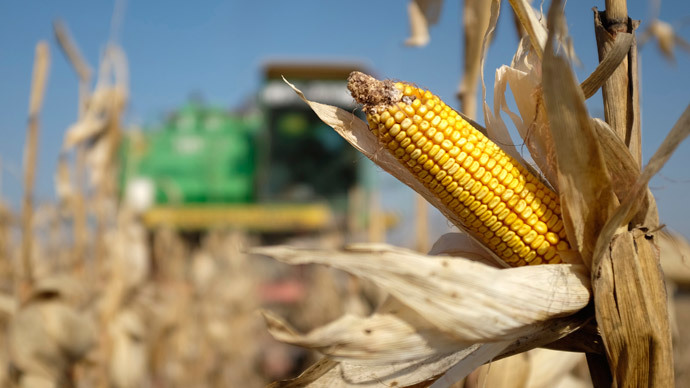EPA issues moratorium on new pesticides that kill birds and bees

The Environmental Protection Agency has issued a moratorium that will restrict the use of new pesticides that have been blamed for declining bee populations, though the policy does not apply to products currently on the market.
The chemicals in question, neonicotinoids, are a new class of insecticides that affect the central nervous system of insects and result in paralysis and death.
READ MORE:Pesticides on fruits and vegetables could account for 49 percent loss in sperm
On Thursday, the EPA sent letters to companies that have applied for permits to use neonicotinoid pesticides, telling them the moratorium stands until they have assessed the risks on bee populations. The pesticides are known to have chronic effects on honey bees, birds, butterflies and other pollinator species, and are considered to be a factor in overall pollinator declines.
“EPA believes that until the data on pollinator health have been received and appropriate risk assessments completed, it is unlikely to be in a position to determine that such uses would avoid ‘unreasonable adverse effects on the environment,” the agency wrote, reported the Hill.
The EPA has made the study of new pollinator risks an agency priority, but the moratorium has no effect on the pesticides already on the market. The EPA also relies on industry-funded science that often contradicts peer-reviewed studies.
Please sign ➙ EPA: Stop the Spread of Bee-killing #Pesticides! http://t.co/Fx6zdguYWn#bees#pollinators Thank you pic.twitter.com/1MzDQQM5JV
— KoalaBee (@Koala_Bee) April 2, 2015
The neonicotinoid moratorium affects the chemicals Imidacloprid, Dinotefuran, Clothianidin and Thiamethoxam. According to research by Beyond Pesticides group, Imidacloprid has been found to be highly toxic to bees and other beneficial insects, upland game birds, and can leach into groundwater. Studies have found it disrupts mobility, navigation and feeding behavior. Other studies have discovered a decrease in foraging activity, olfactory learning and decreased hive activity.
The chemical Clothianidin, when used in Germany, caused a massive bee die-off in 2008, with the country subsequently banning the chemical pending further investigation.
More than 125 farmer, food safety, beekeeper, faith and environmental groups wrote to President Barack Obama last month “urging the moratorium on neonicotinoid and their chemical cousins, other systemic pesticides.”
EPA dials back the use dangerous systemic pesticides http://t.co/8Xs6l4Ho58
— Bob Berwyn (@bberwyn) April 3, 2015
More than 4 million Americans signed petitions urging the Obama administration to take action on bee-toxic pesticides. Among the petitioning groups was The Center for Biological Diversity, who have sued the EPA over its pesticide laws several times.
“This is an important first step in recognizing that these types of bee-killing pesticides have a devastating effect on our pollinators, and our agricultural systems and the environment,” Jonathan Evans, senior attorney at the Center for Biological Diversity, told RT. “Unfortunately it is only a first step and doesn’t address the large scale of these same pesticides that are already approved.”
“In essence, the EPA has recognized these products are dangerous and they are not going to allow new ones,” he continued, before adding that it “will do nothing about the existing harm that is occurring to…pollinators from already registered products.”
READ MORE: Pesticides blamed for clinical depression in farmers
Evans said nearly every day there are new studies linking the impacts of neonicotinoids and other types of systemic pesticides to pollinator decline and adverse environmental harm, but the trouble remains with the broken US pesticide policy. He also blamed the EPA’s own Office of Pesticide Programs, saying it largely protects the chemical industry and rubber stamps getting new pesticides on the market.
The Center for Biological Diversity has brought several lawsuits against the EPA’s support of pesticide use, but the judge has usually ruled in favor of the EPA.
“The pesticide laws are very tilted towards agriculture, and what happens is [a company] provides a cost-benefit analysis where, if [they] can determine if [they] can make so much more profit on producing ‘X’ amount more corn or soy, [the EPA] view that as counterbalancing negative environmental impacts,” said Evans.
Evans said there is a growing integrated pest management movement that looks holistically at the system to determine what other types of beneficial insects can address pesticide problems, or if other types of pesticides can cause less harm.
READ MORE:EPA sued over shrinking monarch butterfly population
He said that in the US there is a “spray first, ask questions later mentality, as opposed to using pesticides when they are really necessary.”
“Now you have the agricultural industry treating every seed – over 80-90 percent of corn or soy are treated with neonicotinoids before they are even planted. They are just bombing everything on the front end to potentially devastate any types of living organisms, even [insects] that would be beneficial, like pollinators.”












